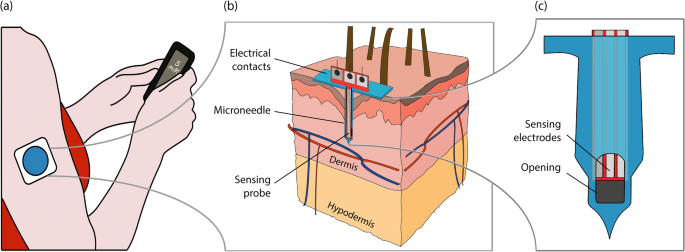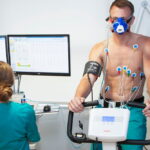What are the Continuous Glucose Monitoring devices?
Continuous glucose monitoring devices are one of the most automated devices for getting information about the change in blood glucose levels of diabetic patients at all times.
How Do These Continuous Glucose Monitoring devices Work?
With today’s Continuous Glucose Monitoring devices CGMs, tiny sensors (electrodes) are inserted under the patient’s skin (usually in the abdominal wall or arm) in a quick and painless way similar to an injection of medication.

The sensor is attached to a tape in place, and it measures changes in glucose levels in the fluid around it between cells of the body and sends the information to a monitor at the size of a pager that is hung on the pants belt around the patient’s waist.
The monitor records glucose levels automatically and continuously around the clock, while the results appear on the display every few minutes.

The sensor should be changed every few days according to the manufacturer’s instructions for each device.

Is it Easy to Use These Continuous Glucose Monitoring devices (CGM)?
These small, complex Continuous Glucose Monitoring devices require some time for the patient to understand their technical aspects and learn, for example, how to insert the sensor correctly, adjust the device according to finger-prick blood glucose readings, set the alarm (for types of devices with alarm), and how to transfer monitoring data to the computer (for long-term analysis), how to respond to readings and change your healthcare plan based on the data collected.
Can a Patient Stop Finger-prick Diabetes monitoring?
The patient can never stop monitoring diabetes using the conventional finger-prick method because it:
- Helps him calibrate the continuous glucose monitoring device on the level of glucose in the blood
- Help him check his blood glucose level before making any changes to his healthcare plan, including:
- Taking a corrective dose of insulin to treat high blood glucose
- Checking the level of glucose in the blood before driving a car or performing any other activity that may be considered dangerous if the patient has hypoglycemia or symptoms of it.
What Are the Benefits of Using Continuous Glucose Monitoring Devices?
The biggest benefit of using these devices is that they provide the patient with information about their blood glucose level every few minutes.
Newer devices display the readings on a screen so that the patient can actually see them and know if glucose levels are high or low, while some devices are provided with an alarm to warn the patient if glucose levels are high or low.
Some devices also display graphs on the screen to show glucose levels recorded during a certain period.
The data collected by all types of these devices can be transferred to a computer for graphing and further analytical studies.
What is the best way to use Continuous Glucose Monitoring devices?
These devices provide information that can be used immediately or after a short or long period of time.
Immediate Use of Information
The Continuous Glucose Monitoring device displays blood glucose levels every few minutes so that the patient can keep track of their glucose level and know which direction they are going.
Depending on what glucose is up or down, a patient may decide to respond to the same reading in different ways.
The patient’s ability to see the trend of glucose levels may allow preventive measures to be taken before these levels lead to any complications.
Use of Information Within a Short Period of Time

A Continuous Glucose Monitoring device may help determine when a moderately severe episode, such as hypoglycemia, may occur, and possibly what triggered it.
Data analysis can help the patient assess his response to the problem and give him an idea of how to reduce its occurrence in the future.
Use of information over a long period of time
Continuous Glucose Monitoring device can analyze blood glucose information at night, during a certain time in the day, or over several days so that the patient can better control their glucose.
Depending on the type of monitor used, the patient may be able to see indicators of the direction the glucose level is taking on the monitor itself, or may need to download the information to a computer.
The patient may wonder why the readings vary in certain periods of time or certain days from others, so questions begin to come to his mind: What usually happens after eating meals? Is it the type of food, the time, or the timing of the insulin dose? And when does hypoglycemia occur? What is the effect of exercise, study, work, or eating out on glucose levels?
During the next visit, the patient should cooperate with the competent healthcare provider to evaluate the data recorded by the Continuous Glucose Monitoring device, in addition to the detailed information recorded about the patient’s daily routine, and to determine the changes necessary to maintain the patient’s blood glucose levels within the required limits, in addition to any other changes from the It will improve the ability to deal with diabetes.
- How to Find a 5-Star Dentist Near You

- Your Easy-Peasy Guide to Brewing Amazing Matcha

- Embracing Holistic Wellness: Insights from a Lansing, MI Health Center

- VO₂ Max Testing Explained: What It Is & Why It Matters for Your Health

- So, what exactly is matcha?

What are the disadvantages of Continuous Glucose Monitoring Devices?
Not all insurance companies cover the cost of these devices, but there is an increase in the number of insurance companies that do.
The patient should check the type of coverage provided by his insurance company regarding the device and its accessories, and make sure to replace the sensor every few days and replace the monitoring devices after a period of six months to two years, according to the manufacturer.
The traditional measurement of blood glucose by the finger-prick method cannot be eliminated.
It is necessary to adjust the CGM device and to confirm the direction of glucose in the blood before taking any corrective measures.
The debate is still raging about the time difference, which ranges from 5-20 minutes, recorded by the monitoring devices
This is because the blood glucose reading is taken from the interstitial fluid and does not reflect the actual blood glucose concentration found in blood samples taken from capillaries using the traditional finger-prick method.
Determining the direction of blood glucose is one of the most important benefits of CGMs, and the time difference is insignificant when the glucose levels that can be seen on the monitor screen are relatively constant.
If the monitor shows a persistent decrease in the level of glucose in the blood over a short period of time, the patient is advised to perform a finger prick diabetes test to detect hypoglycemia.
Conclusion
Continuous Glucose Monitoring devices are expensive, health insurance companies may not cover their cost, they require time and patience to understand their technical aspects, and they should be seen as tools to help the patient take care of his disease.
These devices are useful for accurate monitoring of glucose trends rather than individual ratio readings, in order to reduce the occurrence of health problems or detect them early.







Comments are closed.